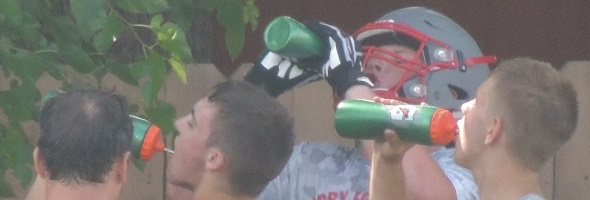
Ross Named Broadcast & Media Coordinator
By
Geoff Kimmerly
MHSAA.com senior editor
February 19, 2021
Jon Ross, bringing vast experience in video production and after working both as television media and in media relations, has been added to the Michigan High School Athletic Association staff as broadcast & media coordinator, a role in which he’ll focus primarily on video production, day-to-day efforts by the MHSAA Network and other communications duties.
 Ross, who began at the MHSAA in late December, is taking on many of the duties formerly handled by John Johnson, who retired Dec. 18 after 33 years as communications director and then director of broadcast properties.
Ross, who began at the MHSAA in late December, is taking on many of the duties formerly handled by John Johnson, who retired Dec. 18 after 33 years as communications director and then director of broadcast properties.
Ross’s variety of past experiences already have served the MHSAA well during his first weeks in his new position. In addition to generating “This Week in High School Sports” played on more than 100 radio stations statewide and the “MHSAA Minute” produced weekly with State Champs! Sports Network, Ross stepped in almost immediately to direct MHSAA Network broadcasts of Fall playoffs that were restarted in January and worked with FOX Sports Detroit for its production of the 8 and 11-Player Football Finals during Jan. 16 and Jan. 22-23, respectively.
“Jon has been a wonderful addition to our team,” MHSAA Executive Director Mark Uyl said. “His background in video production will serve the MHSAA well, and he’s done an outstanding job jumping in mid-stream with our Final fall tournaments being completed in January followed by an immediate move to winter events. Jon is a terrific addition to the MHSAA team.”
Ross began his media career in June 1999 at the first of three television sports department stops, a string that concluded with his tenure as a reporter and anchor from 2002-05 for WILX in Lansing.
Most recently, Ross served from Feb. 2018 until this past December as a communications representative and senior editor for the Michigan Office of Highway Safety Planning, for which he helped manage development of statewide campaigns including “Click It Or Ticket” and “Drive Sober, Get Pulled Over.” In addition to content creation, Ross worked in media relations including as occasional spokesperson for the OHSP, along with managing budgets and execution of federally-funded campaigns and serving as chairperson of the 2019 Michigan Traffic Safety Summit which drew nearly 500 attendees.
At the MHSAA, Ross’s responsibilities also will include providing content for the Association’s websites including the fan-focused Second Half, managing MHSAA.tv and eventually media credentialing and other on-site communications functions at MHSAA events.
“My time working in sports never seemed like work, and I’m excited for the opportunity to be part of what the MHSAA is building as it continues to expand coverage especially with video and other digital ventures,” Ross said. “I’ve known John Johnson going back to my time in the media, and I can appreciate even more now the work he did in making the MHSAA a national leader in promoting school athletics. I hope my experiences will help us build on what he created as we continue to engage more with our schools and specifically athletes, coaches, officials and families to tell our story.”
Ross was born in Escanaba and is a 1995 graduate of Saginaw Heritage High School and 1999 graduate of Michigan State University, where he earned a bachelor’s degree in journalism with specialty in kinesiology.

Athletes: Get Ready to Beat the Heat
August 2, 2019
By Geoff Kimmerly
Second Half editor
While this summer may have seemed to arrive late in many parts of Michigan, the warm and sunny weather over these last few weeks has provided another reminder that student-athletes must prepare for training in hot weather that traditionally accompanies the beginning of August as MHSAA member schools prepare to begin fall sports practices this month.
Each year, the MHSAA provides information to its member schools to help them prepare for hot weather practice and game conditions during the late summer and early fall. Practices for cross country, football, Lower Peninsula girls golf, boys soccer and Lower Peninsula boys and Upper Peninsula girls tennis can begin August 12, with volleyball and Lower Peninsula girls swimming & diving able to start August. 14.
The “Health & Safety” page of the MHSAA Website has a number of links to various publications and information including guidelines for acclimatization from the National Athletic Trainers’ Association and recommendations on proper hydration from the National Federation of State High School Associations (NFHS). The preseason publication Heat Ways also is available for download and includes valuable information on heat management in addition to requirements and resources regarding head injuries and sudden cardiac arrest.
The first days of formal practices in hot weather should be more for heat acclimatization than the conditioning of athletes, and practices in such conditions need planning to become longer and more strenuous over a gradual progression of time. Schools also must consider moving practices to different locations or different times of day, or change practice plans to include different activities depending on the conditions. Furthermore, football practice rules allow for only helmets to be worn during the first two days, only shoulder pads to be added on the third and fourth days, and full pads to not be worn until the fifth day of team practice.
The MHSAA advises student-athletes to make sure to hydrate all day long – beginning before practice, continuing during and also after practice is done. Water and properly-formulated sports drinks are the best choices for hydration, while energy drinks, high-carbohydrate fruit juices (greater than eight percent carb content), carbonated and caffeinated beverages are among those that should be avoided.
A number of member schools follow the MHSAA’s Model Policy for Managing Heat & Humidity, which while not mandated for member schools was adopted as a rule for MHSAA postseason competition in 2013. The plan directs schools to begin monitoring the heat index at the activity site once the air temperature reaches 80 degrees, and provides recommendations when the heat index reaches certain points, including ceasing activities when it rises above 104 degrees. (When the temperature is below 80 degrees, there is no combination of heat and humidity that will result in a need to curtail activity.) The model heat & humidity policy is outlined in a number of places on the MHSAA Website, including as part of Heat Ways.

